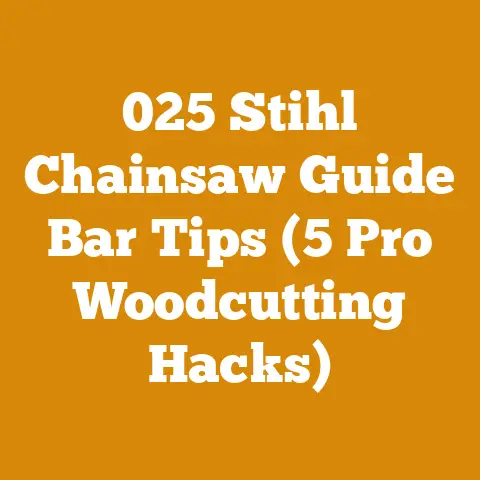Brush Bandit Chippers (5 Pro Tips for Arborists)
“The best time to plant a tree was 20 years ago. The second best time is now.” – Chinese Proverb.
As someone who has spent countless hours in the woods, wrestling with logs and feeding branches into wood chippers, I can attest to the truth in that proverb. The arborist’s world is one of constant growth and adaptation, and the right tools, used skillfully, can make all the difference. Today, I want to share my insights on maximizing the efficiency and safety of Brush Bandit chippers, a workhorse for many of us. These machines are powerful, but like any tool, they require respect and understanding. Let’s dive into five pro tips that will help you get the most out of your Brush Bandit chipper.
Brush Bandit Chippers: 5 Pro Tips for Arborists
Brush Bandit chippers are indispensable tools for arborists, allowing us to efficiently process branches and debris into manageable wood chips. However, these machines are also powerful and potentially dangerous. Proper operation and maintenance are crucial for both safety and productivity. Over the years, I’ve seen firsthand the difference between a well-maintained and expertly operated chipper and one that is neglected and misused. These tips are born from those experiences, and they are designed to help you work smarter and safer.
1. Master the Art of Feeding: Technique is Key
The way you feed material into a Brush Bandit chipper significantly impacts its performance and your safety. It’s not just about shoving branches in and hoping for the best. It’s about finesse, understanding the machine’s capabilities, and adapting to the material you’re feeding.
Proper Branch Orientation
When feeding branches, orient them so the larger end enters the chipper first. This allows the chipper to gradually process the material, reducing the risk of jams and kickback. I’ve seen plenty of instances where feeding smaller, thinner ends first resulted in the chipper struggling and, in some cases, stalling completely.
Feeding Technique
Avoid overloading the chipper. Feed material at a consistent rate, allowing the chipper to process each branch before adding more. A steady stream is far more efficient than large, sporadic bursts. Think of it like a marathon, not a sprint. A smooth, consistent feed rate will keep the chipper running smoothly and prevent unnecessary wear and tear. I once worked with a crew that prided itself on speed, stuffing as much material as possible into the chipper at once. The result? Frequent jams, increased fuel consumption, and a chipper that needed more frequent maintenance.
Dealing with Difficult Material
For forked branches or material with significant bends, use a pole or sturdy branch to guide the material into the chipper. This keeps your hands away from the infeed chute and reduces the risk of injury. Never use your feet to push material into the chipper. I had a close call once when I tried to nudge a stubborn branch with my foot. The chipper suddenly grabbed the branch, and I narrowly avoided serious injury. That was a lesson I learned the hard way, and it’s one I never forget.
Case Study: The Overzealous Feeder
I remember a rookie on one of my crews who thought he could outsmart the chipper. He’d try to cram as much material as possible into the infeed chute, convinced he was speeding things up. In reality, he was causing more problems than he solved. The chipper would frequently jam, requiring us to stop and clear the blockage. Fuel consumption increased, and the chipper’s knives wore out faster. After a few weeks of this, I sat him down and explained the importance of proper feeding technique. I showed him how to orient the branches, how to maintain a consistent feed rate, and how to use a pole to guide difficult material. Within a week, his efficiency improved, and the chipper ran much smoother. It was a clear demonstration of how technique can trump brute force.
Takeaway: Master the art of feeding by orienting branches correctly, maintaining a consistent feed rate, and using tools to guide difficult material. This will improve efficiency, reduce the risk of jams, and enhance safety.
2. Knife Sharpening and Maintenance: The Key to Performance
The sharpness of your chipper knives is directly proportional to its performance. Dull knives require more power to chip material, leading to increased fuel consumption, reduced chipping capacity, and unnecessary strain on the chipper’s engine. Regular sharpening and maintenance are essential for keeping your Brush Bandit chipper running at peak efficiency.
Sharpening Frequency
How often you need to sharpen your knives depends on the type of material you’re chipping and the amount of use the chipper gets. As a general rule, I recommend checking the knives daily and sharpening them every 4-8 hours of operation. You’ll know it’s time to sharpen when you notice the chipper struggling to chip material, producing uneven chips, or requiring more force to feed branches.
Sharpening Techniques
There are several methods for sharpening chipper knives, including using a bench grinder, a belt sander, or a specialized knife sharpener. I prefer using a bench grinder with a fine-grit wheel. The key is to maintain the original bevel angle of the knife and to avoid overheating the steel, which can weaken it. Always wear safety glasses and gloves when sharpening knives.
Knife Inspection
While you’re sharpening the knives, take the opportunity to inspect them for damage. Look for cracks, chips, or excessive wear. Replace any damaged knives immediately. Using damaged knives can not only reduce chipping performance but also pose a safety hazard. A broken knife can become a projectile, causing serious injury.
Knife Alignment
Proper knife alignment is crucial for optimal chipping performance. Ensure that the knives are evenly spaced and properly aligned with the chipper’s anvil. Misaligned knives can cause uneven chipping, increased vibration, and premature wear on the chipper’s components. Refer to your Brush Bandit chipper’s manual for specific instructions on knife alignment.
Data-Driven Maintenance
I started keeping a log of my chipper knife maintenance a few years ago, tracking sharpening frequency, knife replacement intervals, and the type of material I was chipping. This data has been invaluable in optimizing my maintenance schedule. For example, I discovered that I needed to sharpen the knives more frequently when chipping hardwood than when chipping softwood. This allowed me to adjust my maintenance schedule accordingly, saving time and money.
Takeaway: Regular knife sharpening and maintenance are crucial for optimal chipping performance and safety. Check the knives daily, sharpen them every 4-8 hours of operation, inspect them for damage, and ensure proper alignment. Keep a maintenance log to track sharpening frequency and knife replacement intervals.
3. Hydraulic System Health: The Lifeblood of Your Chipper
The hydraulic system is the lifeblood of your Brush Bandit chipper. It powers the infeed rollers, the discharge chute, and other critical components. Maintaining the health of the hydraulic system is essential for ensuring reliable operation and preventing costly repairs.
Fluid Levels and Condition
Check the hydraulic fluid level daily before starting the chipper. Low fluid levels can cause the hydraulic pump to cavitate, leading to damage. Also, inspect the fluid for contamination. Dirty or milky fluid indicates the presence of water or other contaminants, which can damage the hydraulic system’s components. Change the hydraulic fluid according to the manufacturer’s recommendations. I typically change mine every 500 hours of operation, or more frequently if I’m working in dusty or dirty conditions.
Filter Maintenance
Hydraulic filters remove contaminants from the fluid, protecting the hydraulic system’s components. Change the filters regularly according to the manufacturer’s recommendations. Clogged filters can restrict fluid flow, leading to reduced performance and increased wear on the hydraulic pump. I always keep a spare set of hydraulic filters on hand so I can change them whenever necessary.
Hose and Fitting Inspection
Inspect the hydraulic hoses and fittings regularly for leaks, cracks, or other damage. Leaks can cause a loss of hydraulic pressure, leading to reduced performance and potential damage to the hydraulic pump. Replace any damaged hoses or fittings immediately. I’ve learned the hard way that a small leak can quickly turn into a major problem, so it’s always best to address them promptly.
Pressure Testing
Periodically test the hydraulic system’s pressure to ensure it’s within the manufacturer’s specifications. Low pressure can indicate a problem with the hydraulic pump, the control valves, or the hydraulic cylinders. High pressure can indicate a blockage in the system. Consult your Brush Bandit chipper’s manual for specific instructions on pressure testing.
Story Time: The Case of the Neglected Hydraulics
I once encountered a Brush Bandit chipper that had been severely neglected. The hydraulic fluid was black and sludgy, the filters were clogged, and the hoses were cracked and leaking. The chipper’s infeed rollers were sluggish, and the discharge chute barely moved. It was clear that the hydraulic system had been abused. After a thorough cleaning, fluid change, and filter replacement, the chipper’s performance improved dramatically. It was a stark reminder of the importance of hydraulic system maintenance.
Takeaway: Maintain the health of your Brush Bandit chipper’s hydraulic system by checking the fluid levels and condition daily, changing the filters regularly, inspecting the hoses and fittings for damage, and periodically testing the pressure. Neglecting the hydraulic system can lead to reduced performance, costly repairs, and even catastrophic failure.
4. Safety First: Operating Procedures and Awareness
Operating a Brush Bandit chipper is inherently dangerous. The rotating knives, the powerful engine, and the potential for kickback all pose significant risks. Adhering to strict safety procedures and maintaining constant awareness are essential for preventing accidents and injuries.
Personal Protective Equipment (PPE)
Always wear appropriate PPE when operating a Brush Bandit chipper, including safety glasses, hearing protection, gloves, and sturdy footwear. I also recommend wearing long sleeves and pants to protect your skin from flying debris. A hard hat is essential when working around trees.
Pre-Operation Inspection
Before starting the chipper, perform a thorough pre-operation inspection. Check the fluid levels, inspect the hoses and fittings, ensure the knives are sharp and properly aligned, and verify that all safety devices are functioning correctly. Never operate a chipper that is in need of repair.
Clear Communication
Establish clear communication signals with your crew before starting the chipper. Use hand signals or two-way radios to communicate effectively, especially in noisy environments. Make sure everyone understands the emergency shut-down procedure.
Safe Operating Distance
Maintain a safe operating distance from the chipper at all times. Keep bystanders away from the area and never allow anyone to stand in front of the infeed chute. Kickback can occur if the chipper encounters a knot or other obstruction, sending debris flying back towards the operator.
Emergency Shut-Down Procedure
Familiarize yourself with the emergency shut-down procedure. Know how to quickly stop the chipper in case of an accident or malfunction. Practice the shut-down procedure regularly so you can react quickly in an emergency.
Real-World Example: The Importance of PPE
I witnessed a near-miss a few years ago that drove home the importance of PPE. A branch kicked back out of the chipper and struck a crew member in the face. Fortunately, he was wearing safety glasses, which prevented a serious eye injury. Without those glasses, he could have lost his sight. It was a sobering reminder that even seemingly minor safety precautions can make a huge difference.
Takeaway: Safety must be your top priority when operating a Brush Bandit chipper. Always wear appropriate PPE, perform a thorough pre-operation inspection, establish clear communication signals with your crew, maintain a safe operating distance, and familiarize yourself with the emergency shut-down procedure. Never compromise on safety.
5. Understanding Wood Types and Their Impact on Chipping
Not all wood is created equal, and understanding the different types of wood you’re chipping can significantly impact your Brush Bandit chipper’s performance and longevity. Hardwoods and softwoods have different densities and moisture contents, which affect how easily they chip and how much stress they put on the chipper’s components.
Hardwood vs. Softwood
Hardwoods, such as oak, maple, and ash, are denser and more difficult to chip than softwoods, such as pine, fir, and spruce. Chipping hardwoods requires more power and can put more stress on the chipper’s knives and engine. Softwoods, on the other hand, are easier to chip but can produce more dust and debris.
Moisture Content
The moisture content of the wood also affects chipping performance. Wet wood is heavier and more difficult to chip than dry wood. It can also clog the chipper’s knives and discharge chute. Ideally, you should chip wood that has a moisture content of less than 25%. You can use a moisture meter to measure the moisture content of the wood.
Species-Specific Considerations
Different species of wood have different characteristics that can affect chipping performance. For example, some species, like eucalyptus, contain oils that can gum up the chipper’s knives. Other species, like locust, are extremely hard and can dull the knives quickly. Understanding these species-specific considerations can help you adjust your chipping technique and maintenance schedule accordingly.
Optimizing Chipping for Different Wood Types
When chipping hardwoods, use a slower feed rate and ensure that the knives are sharp. When chipping softwoods, you may need to adjust the chipper’s discharge chute to prevent excessive dust. When chipping wet wood, allow the chipper to run at a slightly higher RPM to prevent clogging.
Personal Experience: The Eucalyptus Challenge
I once had a job chipping a large amount of eucalyptus. I quickly discovered that the eucalyptus oil was causing the chipper’s knives to gum up, reducing chipping performance. I tried several different solutions, including using a solvent to clean the knives more frequently and adjusting the chipper’s feed rate. Ultimately, I found that the best solution was to chip the eucalyptus in smaller batches and to clean the knives thoroughly after each batch.
Takeaway: Understanding the different types of wood you’re chipping can help you optimize your Brush Bandit chipper’s performance and longevity. Consider the wood’s density, moisture content, and species-specific characteristics when adjusting your chipping technique and maintenance schedule.
By mastering these five pro tips, you can unlock the full potential of your Brush Bandit chipper, improving efficiency, enhancing safety, and extending the life of your equipment. Remember, the key to success is continuous learning and a commitment to best practices. Now, get out there and make some chips!






